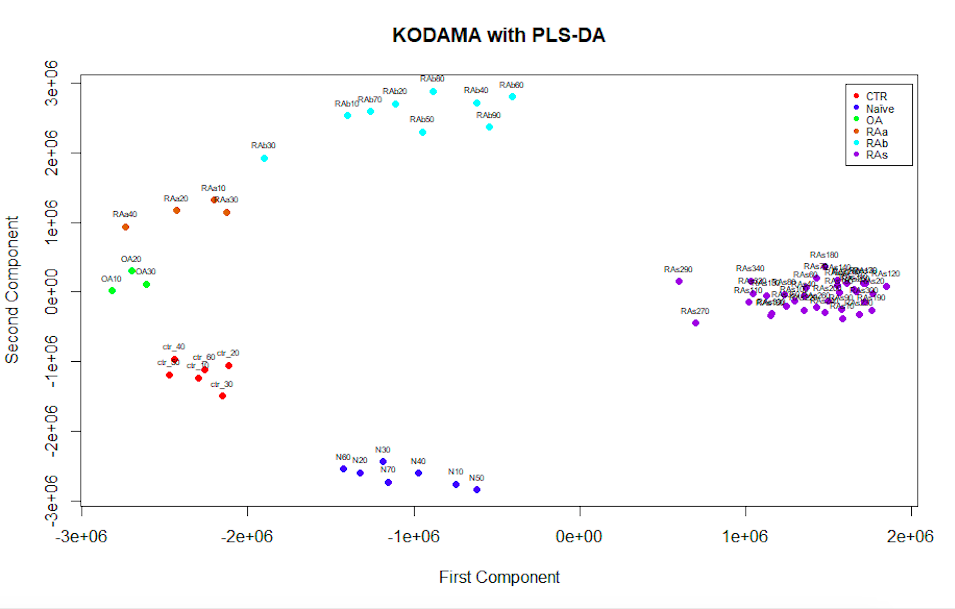Session Information
Session Type: Poster Session A
Session Time: 8:30AM-10:30AM
Background/Purpose: Rheumatoid arthritis (RA) remains a disease with high morbidity. Biologic agents revolutionized the therapy of RA, but they are withdrawn in 50% of patients in 5 years due to loss of efficacy or side-effects. Predictive biomarkers for drug efficacy or side effects are missing while a personalized approach in RA therapy is imperative. Several reports support the notion that specific metabolomics profiles are good predictors for response to TNF blockers. However, the results of many studies are inconclusive due to the small sample size, lack of sequential samples and synchronization of sample collection with initiation or change of therapy.
The aim is to create a metabolic profile for RA patients at different time-points of therapy (DMARDs/bDMARDs), identify biomarkers related to therapy-response, monitor the disease progression, and predict the optimal disease management.
Methods: Plasma was collected from fasted RA patients according to their therapy timepoint: newly diagnosed Naïve (N, n=5) without therapy, before (RAb, n=9) and after (RAa, n=4) therapy (follow up of Naïve and RAb), and patients on standard therapy (RAs, n=35) either DMARD/bDMARD being in a stable condition. Osteoarthritis (OA, n=3) patients and healthy controls (ctr, n=6) were also included in the study. Metabolomic profiling was carried out with 1H NMR spectroscopy. Uni- and multivariate statistical analyses were done to investigate clustering of the experimental groups and define the responsible metabolites. Knowledge Discovery by Accuracy Maximization (KODAMA) was applied for feature extraction in an unsupervised and semi-supervised approach, using principal component analysis-canonical analysis with k-Nearest Neighbor (PCA-CA-kNN) and Partial least squares discriminant analysis (PLS-DA) as classifiers.
Results: Multivariate analysis using KODAMA revealed distinct metabotypes for the six groups, with acetone, tyrosine and alanine, posing the highest importance for discriminating RA patients. Pairwise comparisons using Orthogonal PLS-DA could also differentiate Naïve patients from ctr and RAa patients, as well as RAb from RAa patients. Univariate study showed that RAa patients are characterized by elevated alanine levels compared to the other groups (mean ± SD, 103) 246.8±38.5 in RAa, 174.1±51.2 in RAb, 175.6±40.4 in RAs, 163.9±19.3 in Naïve; p< 0.01. Tyrosine was significantly increased in RAs compared to RAb, 35.5±8.8 vs 24.3±6.9 respectively; p=0.005, while glucose (2943.5±316.0, 3659.8±1166.8; p=0.01) and acetone were decreased (2943.5±316.0, 3659.8±1166.8; p=0.01). Significant alterations were also observed in macromolecule signals attributed to VLDL and LDL, indicating a putative role of these lipoproteins in differentiating Naïve from RAa and RAs patients.
Conclusion: These data confirm that the metabolic profile of RA patients from Greek populations shows differences related to therapeutic treatment. Biomarkers like alanine and tyrosine can help evaluate the response to therapy. Lastly, the lipoprotein profile is expected to provide additional biomarkers to improve patient classification helping the treatment planning.
To cite this abstract in AMA style:
Tsezou K, Benaki D, iliou K, Mikros E, Vlachoyiannopoulos P. Metabolomic Study of Rheumatoid Arthritis Using 1H Nuclear Magnetic Resonance (1H NMR) [abstract]. Arthritis Rheumatol. 2021; 73 (suppl 9). https://acrabstracts.org/abstract/metabolomic-study-of-rheumatoid-arthritis-using-1h-nuclear-magnetic-resonance-1h-nmr/. Accessed .« Back to ACR Convergence 2021
ACR Meeting Abstracts - https://acrabstracts.org/abstract/metabolomic-study-of-rheumatoid-arthritis-using-1h-nuclear-magnetic-resonance-1h-nmr/



